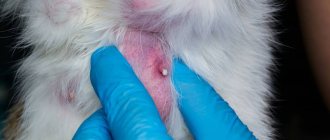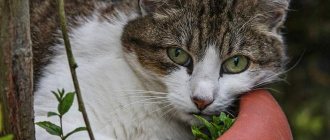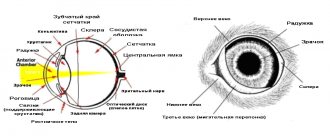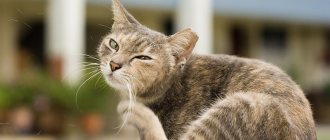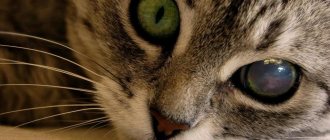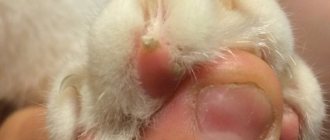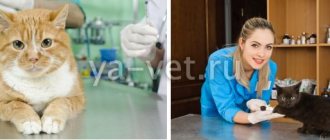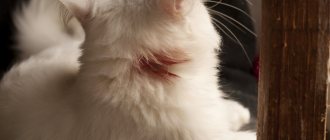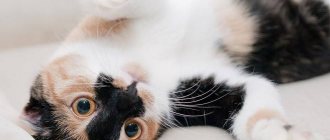Cat owners often have to deal with various health problems with their pets. The lion's share of diseases occurs in the gastrointestinal tract; representatives of the cat family especially often suffer from digestive disorders such as diarrhea or diarrhea. In most cases, bowel dysfunction does not pose a threat to the pet’s life and does not require drug therapy. However, in some cases, frequent loose stools may signal the development of a serious illness. Especially if there is blood in the stool, the animal’s condition deteriorates sharply, an upset stomach is accompanied by vomiting, the temperature rises, etc. In this case, it is important to know what to do and how to properly treat diarrhea in cats.
What is diarrhea in cats
Diarrhea (diarrhea) is not an independent disease; the condition is a signal of the presence of certain health problems in the cat. We are talking about dysfunction of the digestive tract, which is accompanied by excessive loss of fluid, pain in the abdomen, nausea, vomiting, weakness and loss of appetite. In cats, frequent loose stools are caused by increased intestinal motility, provoked by irritation of the intestinal mucosa by pathogenic bacteria or toxins.
Along with frequent defecation, the animal behaves restlessly, experiences discomfort, and often cannot find a place for itself. Despite the fact that in the vast majority of cases, a disorder of the digestive system does not pose a threat to the cat’s life, it is important to understand that prolonged diarrhea can lead to dehydration and can cause the death of the pet. It is extremely important to correctly recognize the symptoms of the disorder and promptly help the animal on your own at home or in a hospital.
Diarrhea is a reason to see a doctor: alarming symptoms that exclude self-medication
In nine cases out of ten, a cat's intestinal disorder, whatever its cause, will go away within a few days without drug intervention. The number of cases where treatment of diarrhea requires antibiotics can be counted on the fingers of one hand. Therefore, it is not at all necessary to drag your cat to the veterinarian as soon as you notice loose stools.
Even if this condition lasts for a long time, there is still no need to rush, since, as my sad experience shows, with the highest degree of probability, the animal will first receive an injection of an antibiotic at the veterinary clinic.
There are not many situations when a cat with diarrhea needs to be shown to a doctor.
Most sources mention four situations when you should immediately seek professional medical help. These are cases when, in addition to diarrhea, the animal experiences:
- signs of dehydration - the cat loses more fluid than it can drink (this is evidenced by severe weight loss, as well as rare urination);
- bloody spots in the stool;
- vomit;
- other symptoms of a general illness (fever, chills, difficulty breathing, rapid pulse, sunken eyes, severe weakness, pale or bluish color of the mucous membranes, etc.).
Video: how to correctly measure a cat's temperature
I have already mentioned Abyssinian kittens who were poisoned while playing with a dish sponge. As soon as the babies’ condition had stabilized a little, the hostess informed us that the girl we had ordered could be picked up. The nursery was located four hundred kilometers from our city. The animal whined pitifully all the way, but, in general, we got there without incident. However, when I woke up the next morning, my daughter found spots of bloody diarrhea all over the apartment and, of course, in a panic she rushed to the veterinary clinic with the unfortunate kitten. The doctor, having heard that the animal had been brought from another city the day before, did not wait for the results of a stool test and, just in case, gave the kitten three injections: “for bacteria”, “for viruses” and “vitamin”. Tests did not reveal any serious pathogens in the animal, but after the “armor-piercing cocktail” the cat’s condition worsened sharply. At the same time, the owner of the cattery, whom I called, not knowing what to do, assured: everything was fine with our cat’s brothers, who remained with their mother, there was no deterioration in their condition. It took a long year and a half until our Abyssinian’s digestion returned to normal, and this happened, oddly enough, only after the cat gave birth. The animal, recovering from chemical poisoning, experienced serious stress from a long move, separation from its mother and brothers, and a complete change of environment. Because of this, the cat’s condition worsened, and bloody spots in the stool apparently occurred due to the fact that the aggressive detergent caused intestinal erosion. All the kitten needed was peace and a gentle diet. Instead, several potent drugs were introduced into his body, which completely disrupted the intestinal microflora. Hence the severe dysbacteriosis, which the unfortunate animal could not cope with for years.
Sometimes childbirth solves the problem of prolonged diarrhea in a cat
When deciding whether to show an animal to a doctor or treat it yourself, it is important not so much to pay attention to specific symptoms, be it blood, vomiting or chills, but rather to use the method of deduction to look for their cause. If a cat has been inundated with chemicals, the blood in the diarrhea is easy to explain, and in this case the animal definitely does not need an antibiotic. Having decided to take your pet to the veterinarian, show persistence and firmness, and do not allow the animal to be injected with potent drugs “just in case.”
Symptoms of diarrhea
The symptoms of diarrhea are pronounced, the condition involves a frequent urge to empty the intestines, while the volume of a single bowel movement is less than usual, and the consistency is liquid. In addition, among the most common symptoms it is worth noting:
- acts of defecation – more than 3 times per day;
- watery, unformed stools;
- fecal incontinence, urgent urge to defecate;
- the color of the feces is light with shades of yellow, green, red if there is diarrhea with blood, and even black if the animal has damage to internal organs.
In addition, vomiting, painful spasms, lethargy, apathy and loss of appetite and other symptoms are often added to the existing picture. It is extremely important to recognize the symptoms in time and identify the root causes of the painful condition in order to understand what to do and what kind of help the cat needs.
Causes
The most common cause of problems with the digestive tract is a change in the cat's usual diet. If frequent bowel movements occurred during the introduction of changes in diet, we can say with confidence that the cause of the disease lies precisely in this. In this case, indigestion can be cured without special therapy. All you need to do is return to your usual food. However, the causes of digestive disorders in cats are not limited only to errors in nutrition; a number of household factors can provoke a painful condition:
- unbalanced diet - the presence in the pet’s diet of raw fish, dairy products, fatty foods, which can cause digestive problems;
- too large portions or frequent feeding;
- transition from natural food to special food or vice versa;
- low-quality water, a change in its usual composition can affect the functioning of the gastrointestinal tract;
- food poisoning: a pet may suffer from consuming spoiled food that has expired;
- individual intolerance to any product, allergies;
- dysfunction of the digestive tract can be caused by medications; manufacturers of veterinary drugs often list diarrhea in the list of side effects;
- postoperative period;
- postpartum rehabilitation and the period of gestation are also often accompanied by gastrointestinal disorders.
Frequent urges to defecate may be caused by an unstable emotional state of the cat. An experienced stressful situation, unfavorable home conditions, excitement, fear, the appearance of other pets in the house, long-term separation from the owner, the arrival of guests, or moving can cause diarrhea. These factors should not be a cause for concern; usually, special treatment is not required, the pet recovers on its own immediately after the disappearance of the traumatic factor.
At the same time, the cause of diarrhea with blood in a pet (or without bloody discharge) may lie in the presence of life-threatening diseases:
- salmonellosis, E. coli infection and other bacterial infections;
- diarrhea and vomiting in a cat with white foam can be caused by viral diseases, including the so-called feline leukemia, rotavirus, panleukopenia, etc.;
- the causes of green diarrhea in a pet can be a consequence of various liver diseases, including pancreatitis;
- diarrhea in cats is caused by pathologies of the digestive system of various etiologies, including partial or complete intestinal obstruction;
- intoxication of the body that developed as a result of complex drug therapy or caused by severe poisoning;
- metabolic disorders, including diabetes;
- parasitic lesions of the body - roundworms, helminthic infestations, worms;
- oncology;
- pathologies of the urinary system;
- fungal infections (mycoses).
Separately, it is worth noting the causes of vomiting with white foam with frequent acts of defecation; their nature is most often physiological, thus the pet independently gets rid of undigested food and toxins. In the absence of accompanying symptoms that aggravate the animal’s health, special treatment is not necessary.
Prevention
Diarrhea is better prevented than treated. During illness, the cat suffers physically and psychologically. Fulfill certain requirements:
- Keep the cat's house or area clean. To do this, change and wash the bedding once a week.
- After eating, throw in any leftover food and rinse the dishes. Sour food will cause poisoning of the body.
- Buy dry food of the highest class, from a well-known manufacturer. If you want to change its brand, do it gradually. So that the animal’s body can adapt to new food.
- Disinfect litter trays.
- As soon as a kitten appears in the house, you need to consult a veterinarian about timely vaccinations. This will prevent many diseases.
- Make it a rule to periodically do preventive treatments against worms (2 times a year).
- Do not keep chemicals that can cause poisoning open or accessible to cats.
- Avoid contact of your pet with animals that have viral infections. Some of them cannot be treated. Before visiting the exhibition, take additional prophylaxis with fosprenyl (against viral diseases).
Types of diarrhea in cats
Depending on the causes of the eating disorder, stool takes on different colors, textures and smells. Based on the analysis of these parameters, it is possible to draw a conclusion about the presence of a particular disease and determine a course of treatment at home.
Classification of diarrhea according to consistency and the presence of foreign impurities in the stool:
- liquid diarrhea, the presence of vomiting most likely indicates food poisoning;
- the presence of mucus in stool indicates damage to the large intestine;
- blood in the stool indicates the infectious nature of diarrhea, the presence of parasites, or indicates damage to internal organs.
Depending on the color of the stool, the following types of diarrhea are distinguished:
- yellow stool – incomplete digestion of food eaten;
- black color - indicates the presence of internal bleeding (you should seek emergency veterinary help or call a veterinarian at home), may also be a consequence of taking medications containing iron or indicate an excessive meat diet;
- green color - with a high degree of probability indicates the consumption of spoiled foods that provoke rotting processes in the intestines; you can treat green diarrhea yourself;
- white color - indicates the presence of problems in the biliary tract;
- orange color - the pet is experiencing severe intoxication and needs emergency help.
Natural products
Food is processed so that it is quickly digested. The meat is boiled, finely chopped or pureed in a blender, mixed with broth. It is useful to make lean minced meat and steam meatballs. Cereals and vegetables are boiled in water or meat broth, then pureed through a sieve.
For the first 3 days, the cat’s food is limited to dietary dishes, foods that irritate the gastrointestinal tract and provoke fermentation are excluded.
The table indicates permitted and forbidden foods:
| Can: | It is forbidden: |
|
|
On the 4th day, low-fat cottage cheese and boiled vegetables are gradually added: carrots, broccoli, cauliflower, pumpkin, zucchini. With diarrhea, the animal eats sluggishly, but it needs to be fed. Appetite is stimulated by attractive smells, and gravy from industrial liquid feed is added to food. If the cat completely refuses to eat, they are taken to a veterinary hospital, where a nutrient solution of glucose with ascorbic acid is injected intravenously. To restore the nervous system, injections of B vitamins are prescribed.
Medicines should not be given without a doctor's advice.
You can support the intestinal microflora without harm using folk remedies:
- Activated charcoal helps remove harmful bacteria from the intestines.
- A decoction of chamomile and St. John's wort reduces inflammation.
- An infusion of oak bark has an astringent effect.
Decoctions are given three times a day, 10 ml, charcoal - twice a day: half a tablet is crushed, mixed with a teaspoon of water and poured through a syringe.

